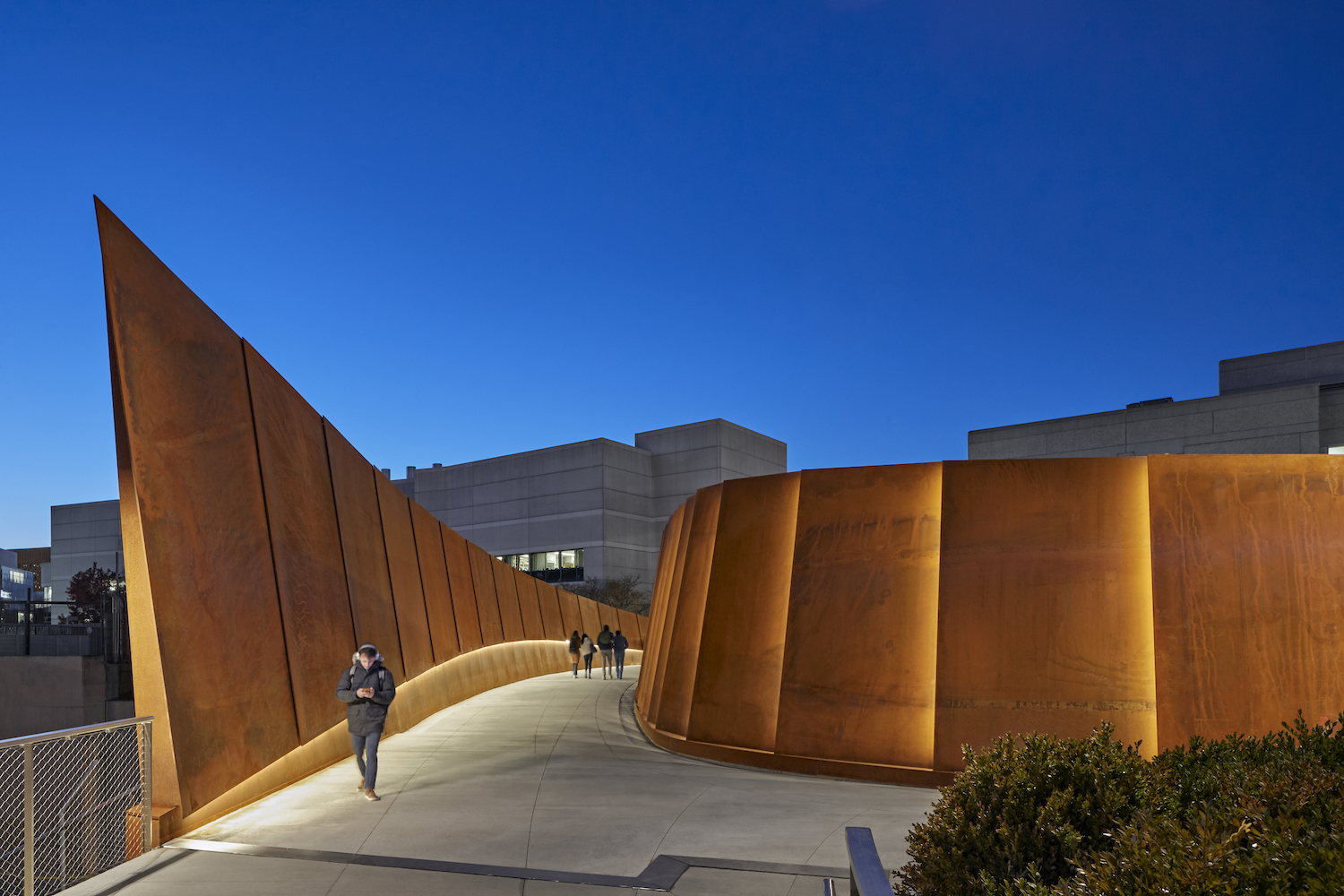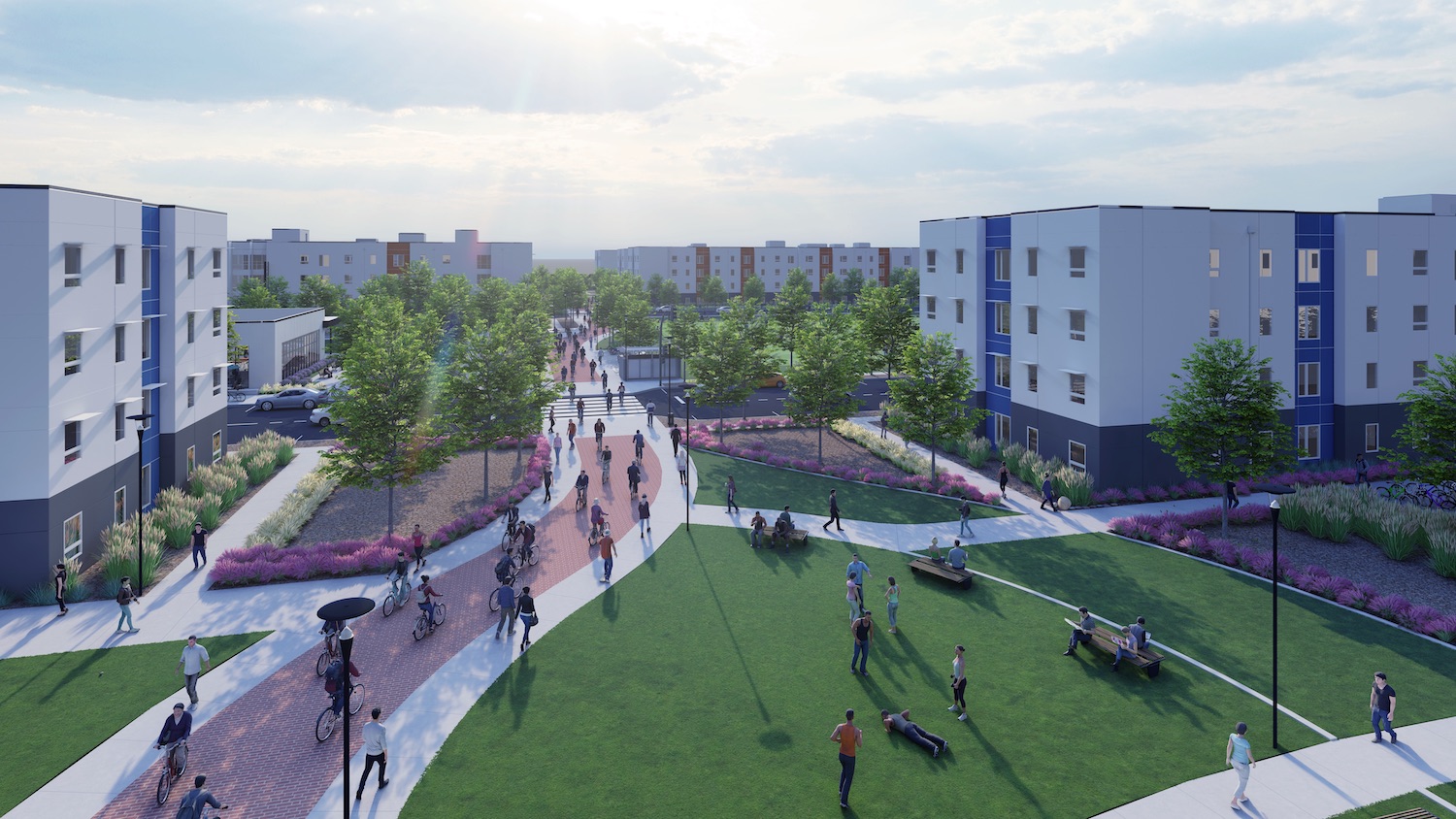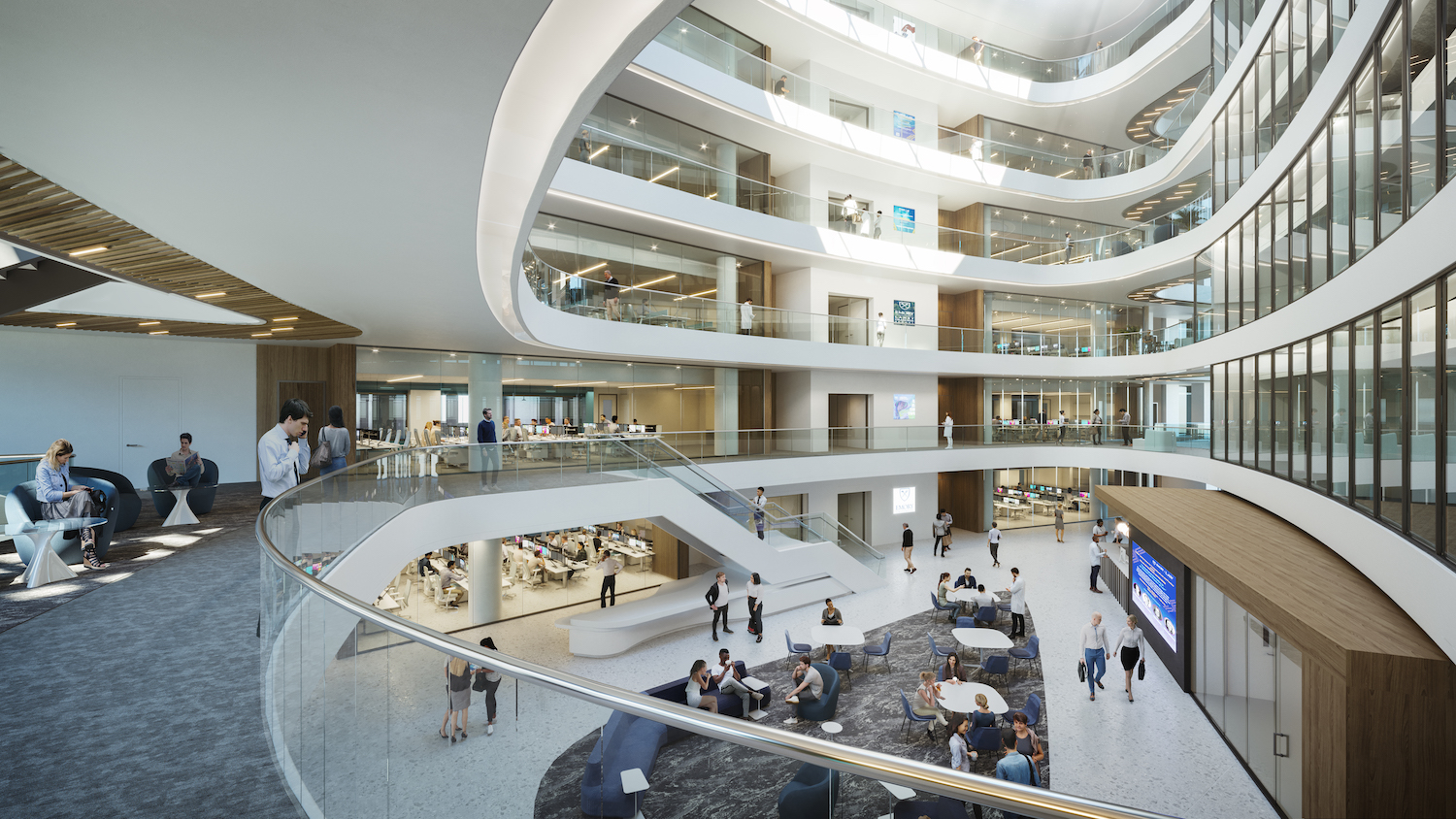Will online learning become a staple for America’s colleges and universities, even after the coronavirus subsides? And if it does, what will that mean for existing and future buildings on campuses across the country?
These have become a fundamental—even existential—questions that AEC firms say their higher ed clients are pondering. While online learning isn’t expected to replace classroom learning over the long run, some firms already see a movement brewing that favors a hybrid model offering collegians both options.
“Colleges and universities are taking immediate steps to de-densify classrooms and residence halls, forcing many institutions to adopt a hybrid pedagogical model whereby approximately one-third of students will receive in-person instruction concurrent with online instruction,” says Patrick McCafferty, Principal and Education Business Leader at Arup’s Boston office. Arup is already sensing diminishing demand for large lecture halls. (McCafferty wonders, though, if a hybrid model might inadvertently create a tiered student experience.)
Chris Purdy, AIA, LEED AP, Vice President and Higher Education Practice Director for SmithGroup, anticipates a “widespread acceptance” of the hybrid learning format. He adds that campus de-densification will require rapid, data-driven strategic planning. Erin Joseph Machau, Jacobs’ Higher Education Market Leader, sees these trends inevitably leading toward more modular and flexible design.

Northeastern University Interdisciplinary Science and Engineering complex. Photo: Tanguy Marquis
“Higher Education will rebound, but the type of projects needed will change,” predicts Machau. “Campus and departmental master planning, facility condition assessments, building and space inventory, and other consulting services will likely increase in need,” as universities lick their wounds from revenue losses, and reboot their space needs in light of what the “campus experience” and “student living” actually mean these days.
“COVID-19 has opened the door for campuses to make big changes for themselves and for their students,” says Tracy De Leuw, DPR Construction’s Higher Ed Core Market Leader. He, too, thinks more schools will focus on hybrid solutions that include combining multiple disciplines—such as business and finance with computer engineering and science—into mini think tanks.
Hybrid learning—such as the HyFlex course design model that gives students the option of attending classes online or physically—depends on technology. Schools are already leveraging technology to offset the impact of social distancing, says Damon Sheppard, HOK’s Regional Leader of Science + Technology. The shift toward learning from home could also spur greater demand for data centers and infrastructure investments, suggests Paul Erb, Executive Vice President for McCarthy Building Companies.
P3s could shore up shortfalls in the university sector
The embrace of hybrid learning, be it tentative or gung-ho, comes at a time when universities are staring at some stark economic realities. The higher education sector is girding for at least a 10% revenue reduction this year as a result of the coronavirus. The suspension of classes and the evacuation of student housing were major hits to many schools’ revenue streams. And going forward, will schools be able to justify what they charge for tuition if courses are delivered online?
The virus “created an unsustainable business model and operating budget gaps,” says Sean Edwards, Suffolk Construction’s COO for Higher Education. That led to pauses in new construction of many capital projects, and slowdowns in the planning and design of projects that weren’t already underway. Erb of McCarthy elaborates that while most of his firm’s higher ed projects already in design are moving forward, future projects have been “pushed out” farther.
Even PCL Construction, which as of mid-June had 23 higher ed projects under construction, expects universities to experience revenue losses from social distancing requirements and the downsizing of dorms, which could force more students into off-campus housing, says Bob Hopfenberg, the firm’s Vice President of National Business Development. PCL predicts more separation within classrooms, and modifications to dorms and residence halls that reduce student occupancies.

Under construction on the campus of the University of California at Davis is the nation’s largest public-private partnership for a student housing project in the U.S. Stantec, The Michaels Organization, and CGB Building Company are part of the team for this complex, which will have 1,875 student beds within nine four-story apartment buildings. Rendering: Stantec
Several AEC firms say their university clients are turning more aggressively to public-private partnerships (P3s) to finance future campus renovation and construction. One of Stantec’s higher ed jobs under construction is at the University of California–Davis: the nation’s largest P3 student housing project to date.
“If universities can’t keep up with demand, they can turn to the private sector for facilities to accommodate student housing and dining,” observes Brent Amos, Principal and Secretary-Treasurer for Cooper Carry. Arup’s McCafferty thinks there will be renewed interest in funding initiatives and investment streams associated with biological sciences and medical research.
The economic turmoil caused by the coronavirus will also thin the herd. Suffolk’s Edwards foresees some smaller institutions merging or being acquired by larger universities. Such consolidations could create opportunities for mixed-use developments that have synergies with universities, such as research labs or commercial space. Other private institutions that don’t choose the P3 or consolidation route might seek to monetize their land assets to generate capital for future construction.
Reassessing space needs in college buildings
The pandemic gave colleges and universities a pressing reason to reevaluate their assets, in order to figure out how they fit into longer-term sustainability plans. For example, about 30% of a typical campus footprint is currently used for administrative and faculty space, notes Patricia Bou, AIA, CannonDesign’s Co-Director–Education Market. Her colleague Charles Smith, AIA, believes that S+T and research facilities could gain importance as part of cross-disciplinary education. “The same goes for healthcare and medical education,” says Smith. “We’re thinking about how to address the intersection of health, science, and data.”
They also suggest that academic institutions should think about alternative uses for dining facilities and recreation centers if their on-campus populations are going to get smaller.
Priorities might change relative to building needs, with a shift in focus toward more adaptation of existing buildings or enhancement of building systems, say Summer Heck, Marketing and BD Manager-Education and S+T at Stantec’s office in Raleigh-Durham, N.C.; and Stephen Phillips, a Vice President at the firm’s Toronto office. “The pandemic will reinforce the rise of renovation and adaptive reuse projects, a trend we’ve been seeing in recent years,” concurs Cooper Carry’s Amos.

Emory University’s Health Research Science Building 2 is scheduled to open in Atlanta in 2022. HOK’s design supports Emory’s campus-wide sustainability efforts and aggressive goals for energy use reduction. Rendering: HOK
Stantec’s executives are seeing a continued focus on career and technical education and skills development. And innovation centers “are at the forefront on institutions’ minds,” they say.
Design professionals like HOK’s Sheppard are now being asked to consider academia’s long-term space strategies, and not just the short-term physical impacts of COVID-19. To that end, Sheppard sees HOK’s role evolving to help clients define how campus space supports their schools’ core missions, determine how much physical space is needed by typology, and assess the value of that space via post-occupancy evaluations.
Suffolk, says Edwards, has moved toward design-assist delivery and virtual design and construction tools to reinforce its expertise to university clients for space planning, building systems, operations, and maintenance.
SmithGroup’s Purdy says his firm is seeing “some exciting opportunities,” including major projects budgeted at $200 million or more, through the firm’s Scenario Mapping projects and CampusForward research. “We are going beyond sustainability and acute shocks, such as earthquakes and floods, to address future disease outbreaks and the chronic stresses of justice and equity.” The goal, he says, is to re-establish the “value” of the on-campus experience.
Related Stories
Architects | May 2, 2024
Emerging considerations in inclusive design
Design elements that consider a diverse population of users make lives better. When it comes to wayfinding, some factors will remain consistent—including accessibility and legibility.
K-12 Schools | Apr 30, 2024
Fully electric Oregon elementary school aims for resilience with microgrid design
The River Grove Elementary School in Oregon was designed for net-zero carbon and resiliency to seismic events, storms, and wildfire. The roughly 82,000-sf school in a Portland suburb will feature a microgrid—a small-scale power grid that operates independently from the area’s electric grid.
AEC Tech | Apr 30, 2024
Lack of organizational readiness is biggest hurdle to artificial intelligence adoption
Managers of companies in the industrial sector, including construction, have bought the hype of artificial intelligence (AI) as a transformative technology, but their organizations are not ready to realize its promise, according to research from IFS, a global cloud enterprise software company. An IFS survey of 1,700 senior decision-makers found that 84% of executives anticipate massive organizational benefits from AI.
Codes and Standards | Apr 30, 2024
Updated document details methods of testing fenestration for exterior walls
The Fenestration and Glazing Industry Alliance (FGIA) updated a document serving a recommended practice for determining test methodology for laboratory and field testing of exterior wall systems. The document pertains to products covered by an AAMA standard such as curtain walls, storefronts, window walls, and sloped glazing. AAMA 501-24, Methods of Test for Exterior Walls was last updated in 2015.
MFPRO+ News | Apr 29, 2024
World’s largest 3D printer could create entire neighborhoods
The University of Maine recently unveiled the world’s largest 3D printer said to be able to create entire neighborhoods. The machine is four times larger than a preceding model that was first tested in 2019. The older model was used to create a 600 sf single-family home made of recyclable wood fiber and bio-resin materials.
K-12 Schools | Apr 29, 2024
Tomorrow's classrooms: Designing schools for the digital age
In a world where technology’s rapid pace has reshaped how we live, work, and communicate, it should be no surprise that it’s also changing the PreK-12 education landscape.
Adaptive Reuse | Apr 29, 2024
6 characteristics of a successful adaptive reuse conversion
In the continuous battle against housing shortages and the surplus of vacant buildings, developers are turning their attention to the viability of adaptive reuse for their properties.
AEC Innovators | Apr 26, 2024
National Institute of Building Sciences announces Building Innovation 2024 schedule
The National Institute of Building Sciences is hosting its annual Building Innovation conference, May 22-24 at the Capital Hilton in Washington, D.C. BI2024 brings together everyone who impacts the built environment: government agencies, contractors, the private sector, architects, scientists, and more.
Mass Timber | Apr 25, 2024
Bjarke Ingels Group designs a mass timber cube structure for the University of Kansas
Bjarke Ingels Group (BIG) and executive architect BNIM have unveiled their design for a new mass timber cube structure called the Makers’ KUbe for the University of Kansas School of Architecture & Design. A six-story, 50,000-sf building for learning and collaboration, the light-filled KUbe will house studio and teaching space, 3D-printing and robotic labs, and a ground-level cafe, all organized around a central core.
Sports and Recreational Facilities | Apr 25, 2024
How pools can positively affect communities
Clark Nexsen senior architects Jennifer Heintz and Dorothea Schulz discuss how pools can create jobs, break down barriers, and create opportunities within communities.

















